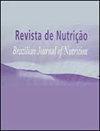2008年至2019年巴西北部地区Rondônia和巴西五岁以下儿童营养状况
IF 0.5
4区 医学
Q4 NUTRITION & DIETETICS
Revista De Nutricao-brazilian Journal of Nutrition
Pub Date : 2022-01-01
DOI:10.1590/1678-9865202235e210211
引用次数: 0
摘要
摘要目的描述Rondônia州5岁以下儿童的营养状况,并将其与巴西北部地区和巴西本土儿童的营养状况进行比较。方法采用时间序列生态学研究。数据收集自食品和营养监测系统。有关按年龄、性别和居住地划分的身体质量指数的资料。采用线性回归进行时间趋势分析,采用Prais-Winsten技术,并在Stata®16.0中使用Durbin和Watson测试进行序列自相关验证。结果除女童和2 ~ 5岁儿童外,不同性别、年龄和地域的儿童的消瘦、超重、超重和肥胖风险以及极端消瘦均呈逐年上升趋势,呈平稳趋势。在男孩和两岁以下的男女儿童中,非富营养化营养状况的年增长趋势高于其他组。在北部地区发现的营养失调的增长率高于Rondônia州和巴西。结论考虑到目前瘦弱和肥胖等极端状况并存的现状,有必要重新审视旨在促进和预防营养问题的卫生政策,特别要关注2岁以下的男孩儿童。本文章由计算机程序翻译,如有差异,请以英文原文为准。
Nutritional status of children under five years of age in Rondônia, Brazil Northern region and in Brazil: 2008 to 2019
ABSTRACT Objective To describe the nutritional profiles of children under five years of age in the state of Rondônia, comparing them with those from the Northern Region of Brazil and from Brazil. Methods This was a time series ecological study. Data were collected from the Food and Nutrition Surveillance System. The information concerned Body Mass Index by age, gender and place of residence. A time-trend analysis was performed using linear regression applying the Prais-Winsten technique and serial autocorrelation verification using the Durbin and Watson test in Stata®16.0. Results There was an annual increasing trend for the thinness, risk of overweight, overweight and obesity regardless of gender, age and location and for extreme thinness, with the exception of girls and for the age of 2 to 5 years, which revealed a stationary trend. Among boys and children of both genders under two years of age, annual growth trends were higher for non-eutrophic nutritional status when compared to the other groups. The growth rates of nutritional disorders found in the Northern region were higher than in the state of Rondônia and in Brazil. Conclusion It is necessary to review health policies aiming at the promotion and prevention of nutritional problems considering the current situation where extreme conditions such as thinness and obesity coexist, with special attention to male children under 2 years of age.
求助全文
通过发布文献求助,成功后即可免费获取论文全文。
去求助
来源期刊
CiteScore
1.20
自引率
12.50%
发文量
24
审稿时长
6-12 weeks
期刊介绍:
Revista de Nutrição is former Revista de Nutrição da Puccamp, founded in 1988. It is a bimonthly publication every four months and it is of responsibility of the Centro de Ciências da Vida, da Pontifícia Universidade Católica de Campinas . It publishes articles that contribute to the study of Nutrition in its many sub-areas and interfaces; and is open to contributions of the national and international scientific communities.

 求助内容:
求助内容: 应助结果提醒方式:
应助结果提醒方式:


